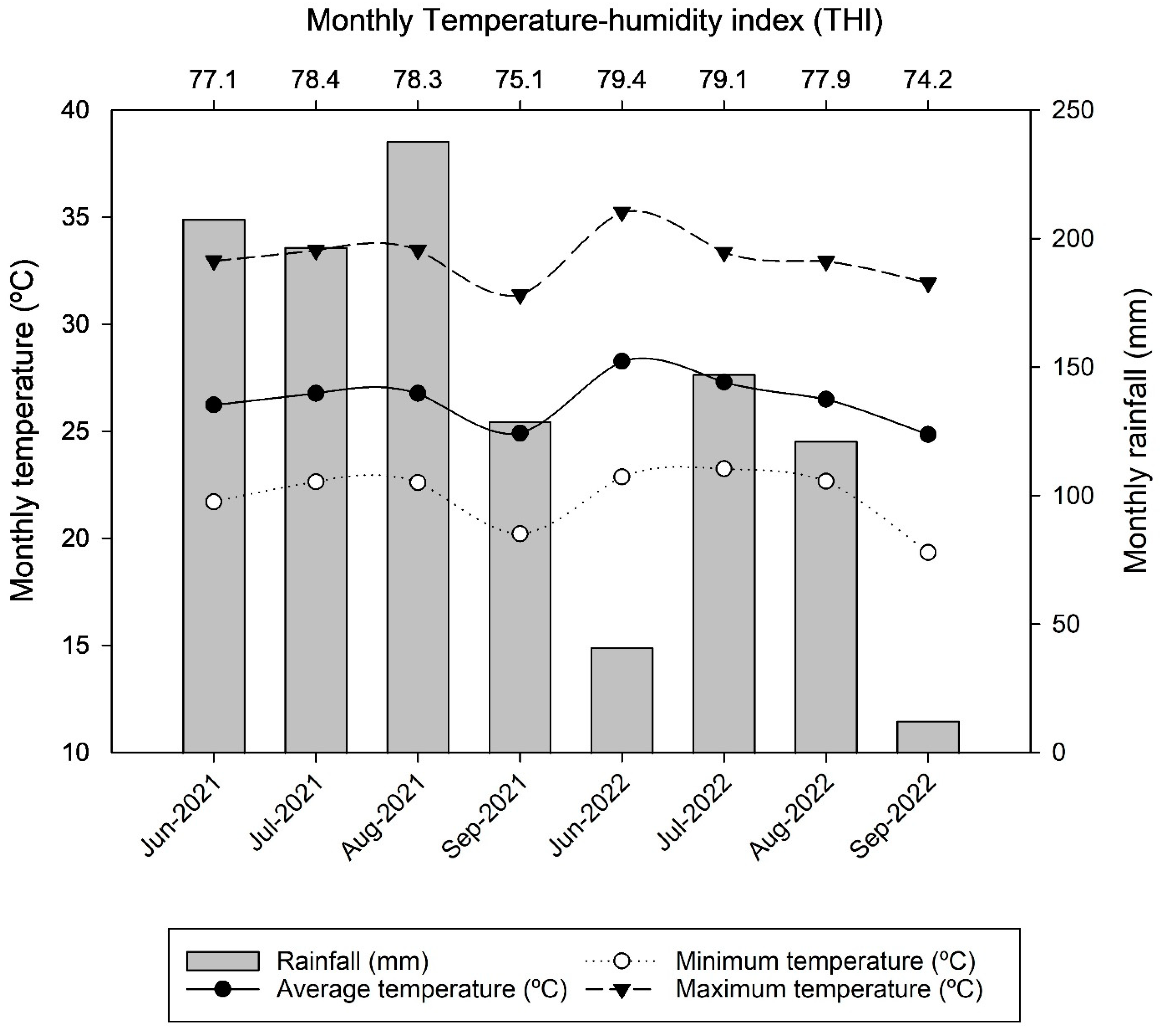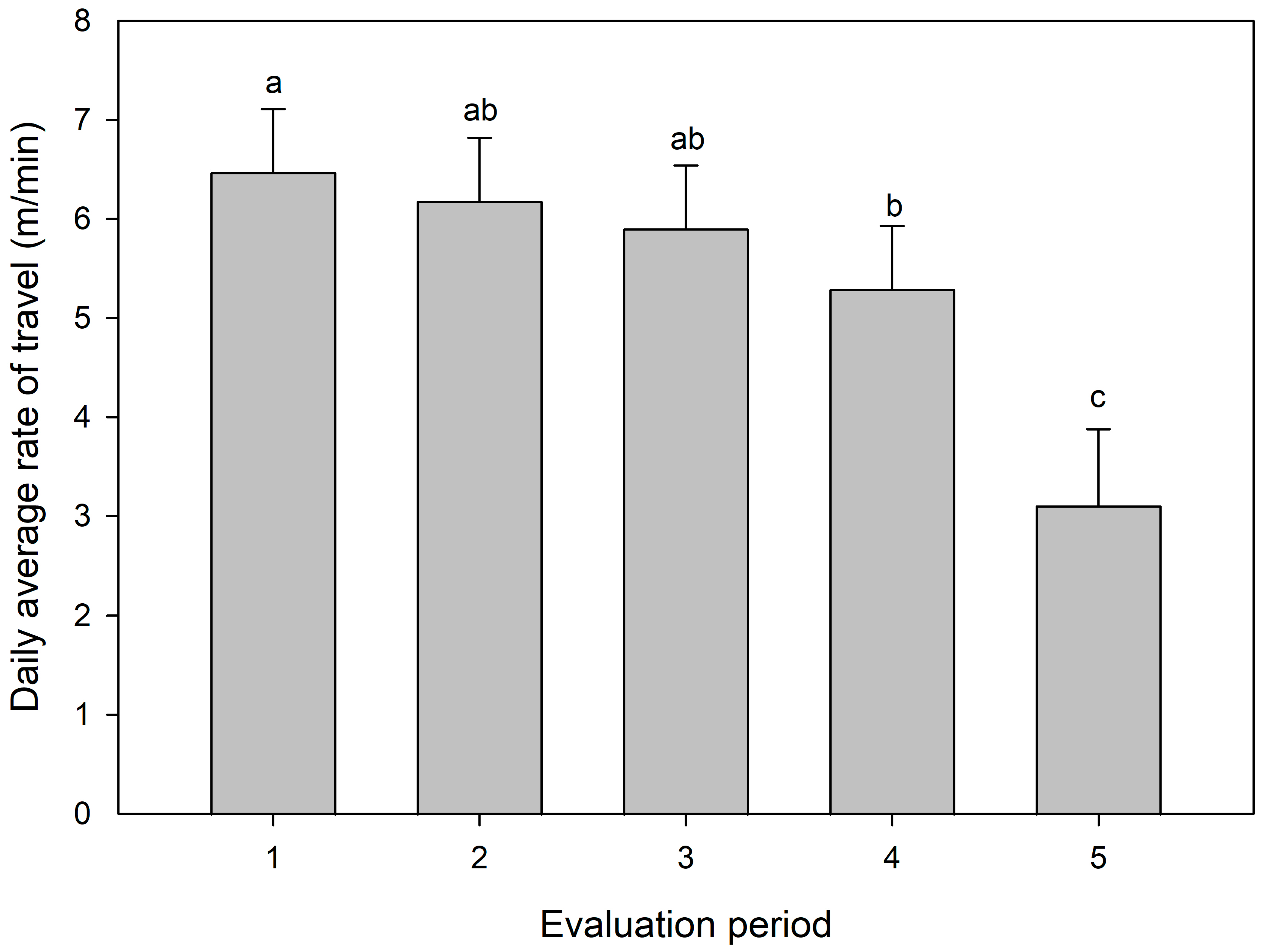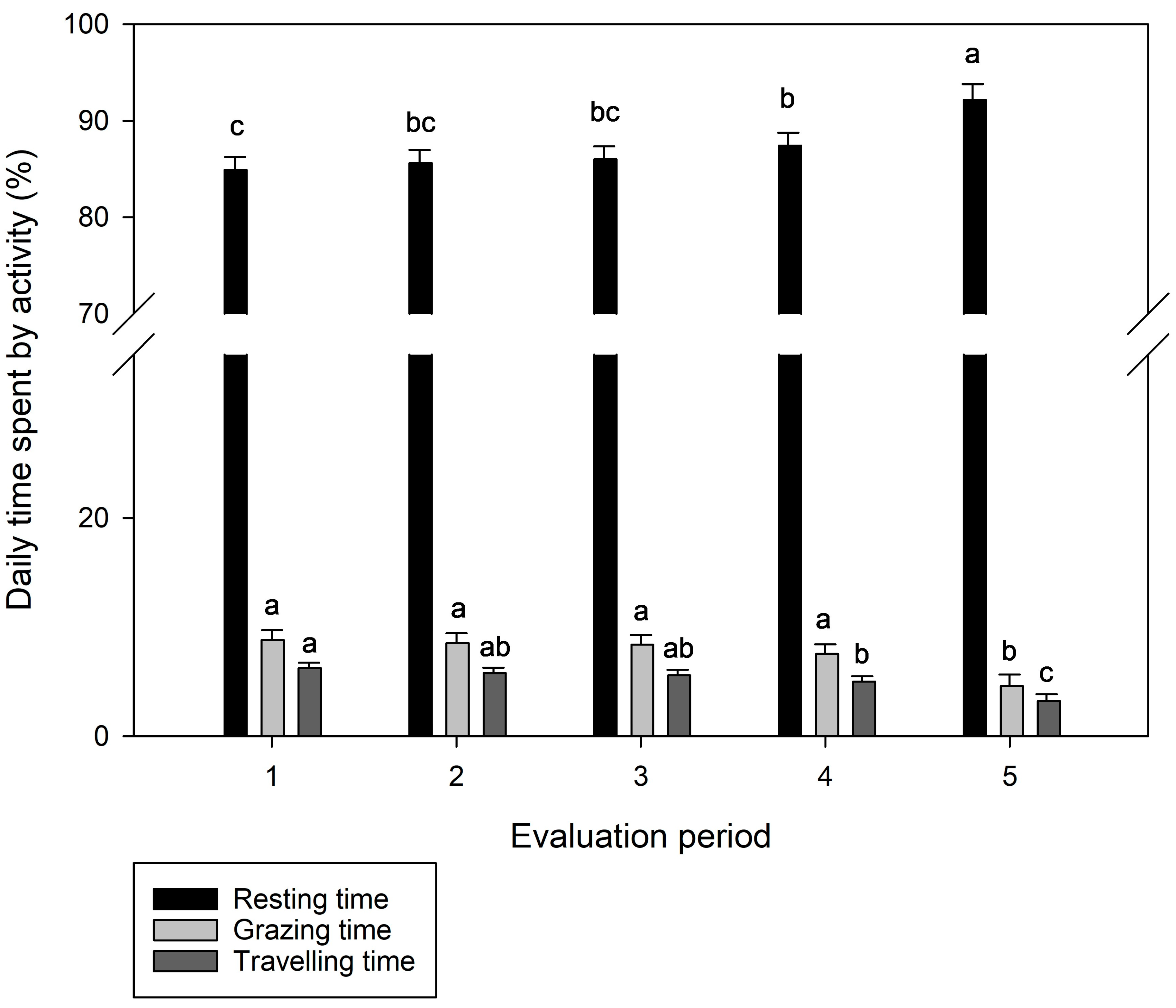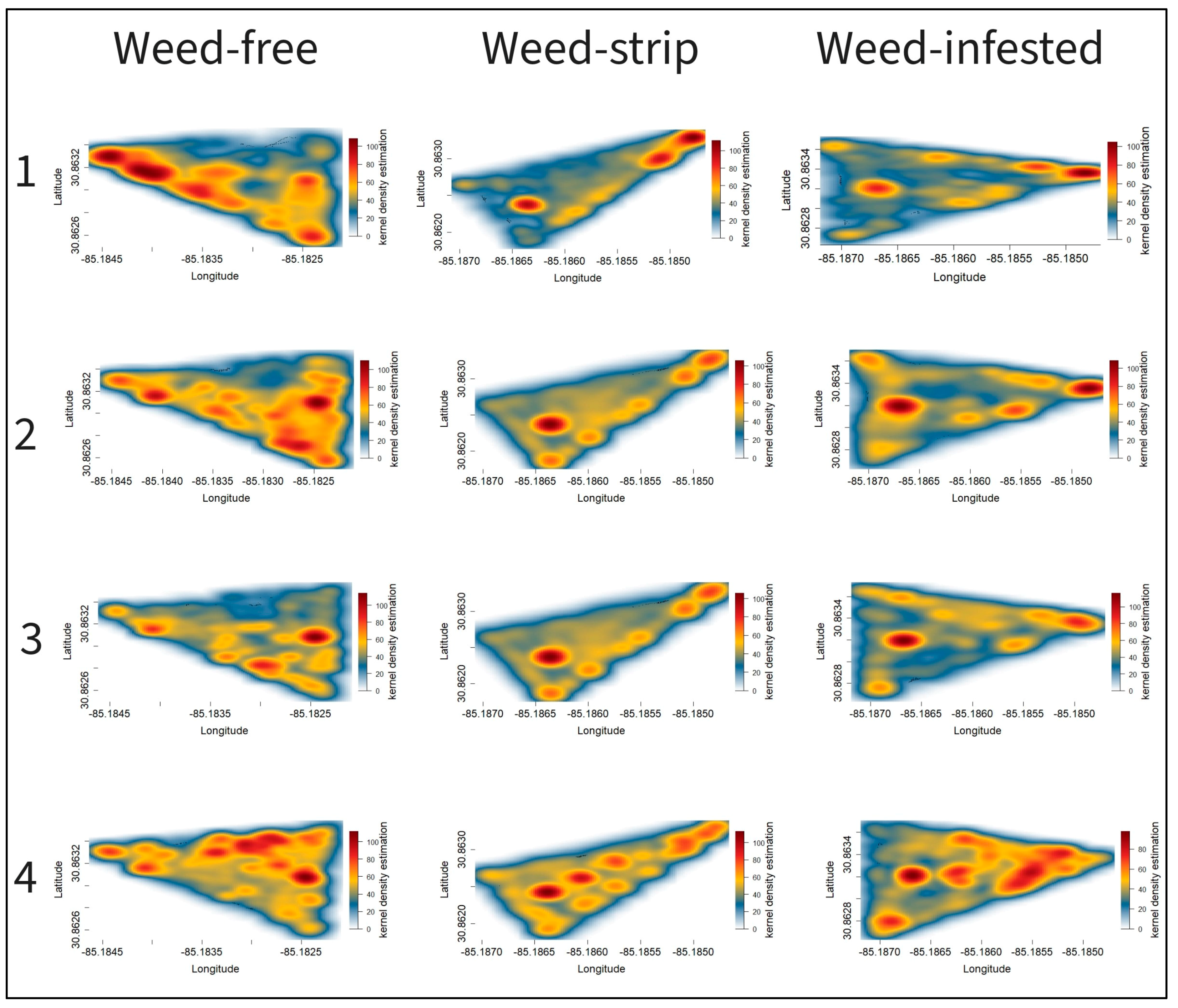Monitoring the Effect of Weed Encroachment on Cattle Behavior in Grazing Systems Using GPS Tracking Collars
Abstract
Simple Summary
Abstract
1. Introduction
2. Materials and Methods
2.1. Site Description and Experimental Design
2.2. Forage and Animal Evaluations
2.3. GPS Collars and Data Collection
2.4. Data Processing and Analysis
2.4.1. Animal Activity
2.4.2. Livestock Spatial Distribution
2.5. Statistical Analysis
3. Results
3.1. Forage and Animal Responses
3.2. Animal Activity
3.3. Livestock Spatial Distribution
4. Discussion
4.1. Forage and Animal Responses
4.2. Animal Activity
4.3. Livestock Spatial Distribution
5. Conclusions
Author Contributions
Funding
Institutional Review Board Statement
Informed Consent Statement
Data Availability Statement
Acknowledgments
Conflicts of Interest
References
- Food and Agriculture Organization of the United Nations (Ed.) The Future of Food and Agriculture: Trends and Challenges; Food and Agriculture Organization of the United Nations: Rome, Italy, 2017; ISBN 978-92-5-109551-5. [Google Scholar]
- Ghanizadeh, H.; Harrington, K.C. Weed Management in New Zealand Pastures. Agronomy 2019, 9, 448. [Google Scholar] [CrossRef]
- Reinermann, S.; Asam, S.; Kuenzer, C. Remote Sensing of Grassland Production and Management—A Review. Remote Sens. 2020, 12, 1949. [Google Scholar] [CrossRef]
- Hamuda, E.; Glavin, M.; Jones, E. A Survey of Image Processing Techniques for Plant Extraction and Segmentation in the Field. Comput. Electron. Agric. 2016, 125, 184–199. [Google Scholar] [CrossRef]
- Schuster, M.Z.; Lustosa, S.B.C.; Pelissari, A.; Harrison, S.K.; Sulc, R.M.; Deiss, L.; Lang, C.R.; de Faccio Carvalho, P.C.; Gazziero, D.L.P.; de Moraes, A. Optimizing Forage Allowance for Productivity and Weed Management in Integrated Crop-Livestock Systems. Agron. Sustain. Dev. 2019, 39, 18. [Google Scholar] [CrossRef]
- Yu, J.; Schumann, A.W.; Cao, Z.; Sharpe, S.M.; Boyd, N.S. Weed Detection in Perennial Ryegrass with Deep Learning Convolutional Neural Network. Front. Plant Sci. 2019, 10, 1422. [Google Scholar] [CrossRef] [PubMed]
- Herbin, A.; Golluscio, R.Á.; Rodriguez, A.M. Weed Effects on the Establishment and Nutritive Value of Pastures with Different Annual/Perennial Ratio. Agrosyst. Geosci. Environ. 2020, 3, e20121. [Google Scholar] [CrossRef]
- Ekwealor, K.U.; Echereme, C.B.; Ofobeze, T.N.; Okereke, C.N. Economic Importance of Weeds: A Review. APRJ 2019, 3, 1–11. [Google Scholar] [CrossRef]
- Sohn, S.-I.; Oh, Y.-J.; Pandian, S.; Lee, Y.-H.; Zaukuu, J.-L.Z.; Kang, H.-J.; Ryu, T.-H.; Cho, W.-S.; Cho, Y.-S.; Shin, E.-K. Identification of Amaranthus Species Using Visible-Near-Infrared (Vis-NIR) Spectroscopy and Machine Learning Methods. Remote Sens. 2021, 13, 4149. [Google Scholar] [CrossRef]
- Sellers, B.A.; Smeda, R.J.; Johnson, W.G.; Kendig, J.A.; Ellersieck, M.R. Comparative Growth of Six Amaranthus Species in Missouri. Weed Sci. 2003, 51, 329–333. [Google Scholar] [CrossRef]
- Hein, D.G.; Miller, S.D. Influence of Leafy Spurge on Forage Utilization by Cattle. J. Range Manag. 1992, 45, 405. [Google Scholar] [CrossRef]
- Nice, G.R.W.; Johnson, B.; Jordan, T.N. Purdue Extension. 1 April 2023. Available online: https://mdc.itap.purdue.edu/item.asp?Item_Number=WS-44-W (accessed on 27 October 2023).
- Ferrell, J.A.; Sellers, B. Spiny Amaranth (Spiny Pigweed) Control in Pastures: SS AGR 288/AG292, 10/2007. EDIS 2007, 2007. [Google Scholar] [CrossRef]
- Carvalho, R.M.; Pimentel, R.M.; Fonseca, D.M.; Santos, M.E.R. Caracterização de perfilhos em relação à planta daninha no pasto de capim-braquiária. Bol. Ind. Anim. 2016, 73, 103–110. [Google Scholar] [CrossRef][Green Version]
- Santos, M.E.R.; da Fonseca, D.M.; Gomes, V.M.; Pimentel, R.M.; Silva, G.P.; Albino, R.L. Estrutura do capim-braquiária em relação à planta daninha. Acta Sci. Anim. Sci. 2011, 33, 233–239. [Google Scholar] [CrossRef]
- Souza, E.J.O.; Queiroz, L.M.D.; de Lima, E.I.M.; Costa, G.R.d.R.; Torres, T.R.; Bezerra, A.C.; Santos, W.M.; Silva, C.S. Can GPS Monitoring Help Farmers Select the Best Nutritional Management Strategy for Finishing Sheep on Pasture? Livest. Sci. 2023, 272, 105229. [Google Scholar] [CrossRef]
- Ilyas, Q.M.; Ahmad, M. Smart Farming: An Enhanced Pursuit of Sustainable Remote Livestock Tracking and Geofencing Using IoT and GPRS. Wirel. Commun. Mob. Comput. 2020, 2020, 6660733. [Google Scholar] [CrossRef]
- Odintsov Vaintrub, M.; Levit, H.; Chincarini, M.; Fusaro, I.; Giammarco, M.; Vignola, G. Review: Precision Livestock Farming, Automats and New Technologies: Possible Applications in Extensive Dairy Sheep Farming. Animal 2021, 15, 100143. [Google Scholar] [CrossRef] [PubMed]
- Rivero, M.J.; Grau-Campanario, P.; Mullan, S.; Held, S.D.E.; Stokes, J.E.; Lee, M.R.F.; Cardenas, L.M. Factors Affecting Site Use Preference of Grazing Cattle Studied from 2000 to 2020 through GPS Tracking: A Review. Sensors 2021, 21, 2696. [Google Scholar] [CrossRef]
- McIntosh, M.M.; Cibils, A.F.; Estell, R.E.; Gong, Q.; Cao, H.; Gonzalez, A.L.; Nyamuryekung’e, S.; Spiegal, S.A. Can Cattle Geolocation Data Yield Behavior-Based Criteria to Inform Precision Grazing Systems on Rangeland? Livest. Sci. 2022, 255, 104801. [Google Scholar] [CrossRef]
- Nyamuryekung’e, S.; Cibils, A.F.; Estell, R.E.; VanLeeuwen, D.; Steele, C.; Estrada, O.R.; Almeida, F.A.R.; González, A.L.; Spiegal, S. Do Young Calves Influence Movement Patterns of Nursing Raramuri Criollo Cows on Rangeland? Rangel. Ecol. Manag. 2020, 73, 84–92. [Google Scholar] [CrossRef]
- Kilgour, R.J. In Pursuit of “Normal”: A Review of the Behaviour of Cattle at Pasture. Appl. Anim. Behav. Sci. 2012, 138, 1–11. [Google Scholar] [CrossRef]
- Nunes Marsiglio Sarout, B.; Waterhouse, A.; Duthie, C.-A.; Candal Poli, C.H.E.; Haskell, M.J.; Berger, A.; Umstatter, C. Assessment of Circadian Rhythm of Activity Combined with Random Regression Model as a Novel Approach to Monitoring Sheep in an Extensive System. Appl. Anim. Behav. Sci. 2018, 207, 26–38. [Google Scholar] [CrossRef]
- Brennan, J.; Johnson, P.; Olson, K. Classifying Season Long Livestock Grazing Behavior with the Use of a Low-Cost GPS and Accelerometer. Comput. Electron. Agric. 2021, 181, 105957. [Google Scholar] [CrossRef]
- Kim, W.S.; Ghassemi Nejad, J.; Peng, D.Q.; Jo, Y.H.; Kim, J.; Lee, H.G. Effects of Different Protein Levels on Growth Performance and Stress Parameters in Beef Calves under Heat Stress. Sci. Rep. 2022, 12, 8113. [Google Scholar] [CrossRef] [PubMed]
- Haydock, K.; Shaw, N. The Comparative Yield Method for Estimating Dry Matter Yield of Pasture. Aust. J. Exp. Agric. 1975, 15, 663. [Google Scholar] [CrossRef]
- Wilm, H.G.; Costello, D.F.; Klipple, G.E. Estimating Forage Yield by the Double-Sampling Method. Agron. J. 1944, 36, 194–203. [Google Scholar] [CrossRef]
- Queiroz, L.M.D.; Dubeux, J.C.B.; Sollenberger, L.E.; Wallau, M.O.; Loures, D.R.S.; Santos, E.; Oduor, K. Spiny Pigweed Encroachment Affects Animal and Herbage Performance. In Proceedings of the ASA, CSSA, SSSA International Annual Meeting, Forage and Grazinglands, Baltimore, MD, USA, 6–9 November 2022. [Google Scholar]
- Sollenberger, L.E.; Moore, J.E.; Allen, V.G.; Pedreira, C.G.S. Reporting Forage Allowance in Grazing Experiments. Crop Sci. 2005, 45, 896–900. [Google Scholar] [CrossRef]
- Knight, C.W.; Bailey, D.W.; Faulkner, D. Low-Cost Global Positioning System Tracking Collars for Use on Cattle. Rangel. Ecol. Manag. 2018, 71, 506–508. [Google Scholar] [CrossRef]
- Morris, G.; Conner, L.M. Assessment of Accuracy, Fix Success Rate, and Use of Estimated Horizontal Position Error (EHPE) to Filter Inaccurate Data Collected by a Common Commercially Available GPS Logger. PLoS ONE 2017, 12, e0189020. [Google Scholar] [CrossRef]
- Augustine, D.; Derner, J. Assessing Herbivore Foraging Behavior with GPS Collars in a Semiarid Grassland. Sensors 2013, 13, 3711–3723. [Google Scholar] [CrossRef]
- Handcock, R.; Swain, D.; Bishop-Hurley, G.; Patison, K.; Wark, T.; Valencia, P.; Corke, P.; O’Neill, C. Monitoring Animal Behaviour and Environmental Interactions Using Wireless Sensor Networks, GPS Collars and Satellite Remote Sensing. Sensors 2009, 9, 3586–3603. [Google Scholar] [CrossRef]
- Johnson, D.E.; Wilson, M.; Wilson, K.D.; Larson, L.L.; Williams, J.; Ndzeidze, S.K.; Clark, P.E. Oregon Beef Council Report. 2009. Available online: https://blogs.oregonstate.edu/beefcattle/ (accessed on 27 October 2023).
- McGavin, S.L.; Bishop-Hurley, G.J.; Charmley, E.; Greenwood, P.L.; Callaghan, M.J. Effect of GPS Sample Interval and Paddock Size on Estimates of Distance Travelled by Grazing Cattle in Rangeland, Australia. Rangel. J. 2018, 40, 55. [Google Scholar] [CrossRef]
- Johnson, D.D.; Ganskopp, D.C. GPS Collar Sampling Frequency: Effects on Measures of Resource Use. Rangel. Ecol. Manag. 2008, 61, 226–231. [Google Scholar] [CrossRef]
- Ranacher, P.; Brunauer, R.; Trutschnig, W.; Van Der Spek, S.; Reich, S. Why GPS Makes Distances Bigger than They Are. Int. J. Geogr. Inf. Sci. 2016, 30, 316–333. [Google Scholar] [CrossRef]
- Owen-Smith, N.; Fryxell, J.M.; Merrill, E.H. Foraging Theory Upscaled: The Behavioural Ecology of Herbivore Movement. Philos. Trans. R. Soc. B 2010, 365, 2267–2278. [Google Scholar] [CrossRef]
- Méndez, D.G.; Di Marco, O.N.; Corva, P.M. Energy Expenditure of Cattle Walking on a Flat Terrain. Anim. Sci. 1996, 63, 39–44. [Google Scholar] [CrossRef]
- Wilson, R.P.; Börger, L.; Holton, M.D.; Scantlebury, D.M.; Gómez-Laich, A.; Quintana, F.; Rosell, F.; Graf, P.M.; Williams, H.; Gunner, R.; et al. Estimates for Energy Expenditure in Free-living Animals Using Acceleration Proxies: A Reappraisal. J. Anim. Ecol. 2020, 89, 161–172. [Google Scholar] [CrossRef]
- Belaid, M.A.; Rodriguez-Prado, M.; Chevaux, E.; Calsamiglia, S. The Use of an Activity Monitoring System for the Early Detection of Health Disorders in Young Bulls. Animals 2019, 9, 924. [Google Scholar] [CrossRef]
- Do, J.P.; Defensor, E.B.; Ichim, C.V.; Lim, M.A.; Mechanic, J.A.; Rabe, M.D.; Schaevitz, L.R. Automated and Continuous Monitoring of Animal Welfare through Digital Alerting. Comp. Med. 2020, 70, 313–327. [Google Scholar] [CrossRef]
- Santos, C.A.D.; Landim, N.M.D.; Araújo, H.X.D.; Paim, T.D.P. Automated Systems for Estrous and Calving Detection in Dairy Cattle. AgriEngineering 2022, 4, 475–482. [Google Scholar] [CrossRef]
- Wang, J.; Bell, M.; Liu, X.; Liu, G. Machine-Learning Techniques Can Enhance Dairy Cow Estrus Detection Using Location and Acceleration Data. Animals 2020, 10, 1160. [Google Scholar] [CrossRef]
- Nyamuryekung’e, S.; Duff, G.; Utsumi, S.; Estell, R.; McIntosh, M.M.; Funk, M.; Cox, A.; Cao, H.; Spiegal, S.; Perea, A.; et al. Real-Time Monitoring of Grazing Cattle Using LORA-WAN Sensors to Improve Precision in Detecting Animal Welfare Implications via Daily Distance Walked Metrics. Animals 2023, 13, 2641. [Google Scholar] [CrossRef]
- Riaboff, L.; Couvreur, S.; Madouasse, A.; Roig-Pons, M.; Aubin, S.; Massabie, P.; Chauvin, A.; Bédère, N.; Plantier, G. Use of Predicted Behavior from Accelerometer Data Combined with GPS Data to Explore the Relationship between Dairy Cow Behavior and Pasture Characteristics. Sensors 2020, 20, 4741. [Google Scholar] [CrossRef]
- Hassan-Vásquez, J.A.; Maroto-Molina, F.; Guerrero-Ginel, J.E. GPS Tracking to Monitor the Spatiotemporal Dynamics of Cattle Behavior and Their Relationship with Feces Distribution. Animals 2022, 12, 2383. [Google Scholar] [CrossRef]
- Sather, B.C.; Kallenbach, R.L.; Sexten, W.J.; Bradley, K.W. Evaluation of Cattle Grazing Distribution in Response to Weed and Legume Removal in Mixed Tall Fescue (Schedonorus phoenix) and Legume Pastures. Weed Technol. 2013, 27, 101–107. [Google Scholar] [CrossRef]
- Dubeux, J.C.B.; Sollenberger, L.E.; Vendramini, J.M.B.; Interrante, S.M.; Lira, M.A. Stocking Method, Animal Behavior, and Soil Nutrient Redistribution: How Are They Linked? Crop Sci. 2014, 54, 2341–2350. [Google Scholar] [CrossRef]








| Evaluation Period | Date | |
|---|---|---|
| Cycle 1 | Cycle 2 | |
| 1 | 6 July 2021 | 12 July 2022 |
| 2 | 28 July 2021 | 3 August 2022 |
| 3 | 19 August 2021 | 25 August 2022 |
| 4 | 10 September 2021 | 16 September 2022 |
| 5 | - | 8 October 2022 |
| Weed-Free | Weed-Strip | Weed-Infested | SEM | p-Value | |
|---|---|---|---|---|---|
| Bermudagrass HM (kg DM ha−1) | 2993 | 3114 | 3021 | 98 | 0.50 |
| Spiny pigweed HM (kg DM ha−1) | - | 1024 b | 2740 a | 383 | <0.01 |
| Total HM (kg DM ha−1) | 2993 c | 4138 b | 5761 a | 644 | <0.01 |
| ADG (kg hd−1 d−1) | 0.28 | 0.36 | 0.26 | 0.05 | 0.44 |
| Stocking rate (AU * ha1) | 4.7 | 4.7 | 4.5 | 0.12 | 0.39 |
| Herbage allowance (Kg DM kg−1 BW) | 2.1 | 2.2 | 2.2 | 0.10 | 0.08 |
| Item | Weed-Infested | Weed-Strip | Weed-Free | SEM | p-Value |
|---|---|---|---|---|---|
| Distance traveled (m/day) | 5657 a | 5079 ab | 4482 b | 417 | 0.02 |
| Rate of travel (m/min) | 6.0 a | 5.0 b | 5.1 b | 0.60 | 0.045 |
| Item | Weed-Infested | Weed-Strip | Weed-Free | SEM | p-Value |
|---|---|---|---|---|---|
| Resting time (%) | 85.1 b | 87.8 ab | 88.8 a | 1.36 | 0.03 |
| Grazing time (%) | 8.9 a | 7.2 b | 6.6 b | 0.86 | 0.02 |
| Traveling time (%) | 6.0 | 4.9 | 4.7 | 0.63 | 0.09 |
| Time Spent (%) | Weed-Infested | Weed-Strip | Weed-Free | SEM | p-Value | LPI |
|---|---|---|---|---|---|---|
| Shade | 23.4 | 20.0 | 20.2 | 3.4 | 0.7 | 13.8 |
| Water | 6.8 | 13.5 | 12.6 | 2.6 | 0.2 | 28.5 |
| Bermudagrass strips | - | 37.3 a | - | 4.6 | 0.01 | 0.7 |
| Spiny pigweed strips | - | 29.1 b | - | 0.6 |
Disclaimer/Publisher’s Note: The statements, opinions and data contained in all publications are solely those of the individual author(s) and contributor(s) and not of MDPI and/or the editor(s). MDPI and/or the editor(s) disclaim responsibility for any injury to people or property resulting from any ideas, methods, instructions or products referred to in the content. |
© 2023 by the authors. Licensee MDPI, Basel, Switzerland. This article is an open access article distributed under the terms and conditions of the Creative Commons Attribution (CC BY) license (https://creativecommons.org/licenses/by/4.0/).
Share and Cite
Bretas, I.L.; Dubeux, J.C.B., Jr.; Cruz, P.J.R.; Queiroz, L.M.D.; Ruiz-Moreno, M.; Knight, C.; Flynn, S.; Ingram, S.; Pereira Neto, J.D.; Oduor, K.T.; et al. Monitoring the Effect of Weed Encroachment on Cattle Behavior in Grazing Systems Using GPS Tracking Collars. Animals 2023, 13, 3353. https://doi.org/10.3390/ani13213353
Bretas IL, Dubeux JCB Jr., Cruz PJR, Queiroz LMD, Ruiz-Moreno M, Knight C, Flynn S, Ingram S, Pereira Neto JD, Oduor KT, et al. Monitoring the Effect of Weed Encroachment on Cattle Behavior in Grazing Systems Using GPS Tracking Collars. Animals. 2023; 13(21):3353. https://doi.org/10.3390/ani13213353
Chicago/Turabian StyleBretas, Igor L., Jose C. B. Dubeux, Jr., Priscila J. R. Cruz, Luana M. D. Queiroz, Martin Ruiz-Moreno, Colt Knight, Scott Flynn, Sam Ingram, Jose D. Pereira Neto, Kenneth T. Oduor, and et al. 2023. "Monitoring the Effect of Weed Encroachment on Cattle Behavior in Grazing Systems Using GPS Tracking Collars" Animals 13, no. 21: 3353. https://doi.org/10.3390/ani13213353
APA StyleBretas, I. L., Dubeux, J. C. B., Jr., Cruz, P. J. R., Queiroz, L. M. D., Ruiz-Moreno, M., Knight, C., Flynn, S., Ingram, S., Pereira Neto, J. D., Oduor, K. T., Loures, D. R. S., Novo, S. F., Trumpp, K. R., Acuña, J. P., & Bernardini, M. A. (2023). Monitoring the Effect of Weed Encroachment on Cattle Behavior in Grazing Systems Using GPS Tracking Collars. Animals, 13(21), 3353. https://doi.org/10.3390/ani13213353








